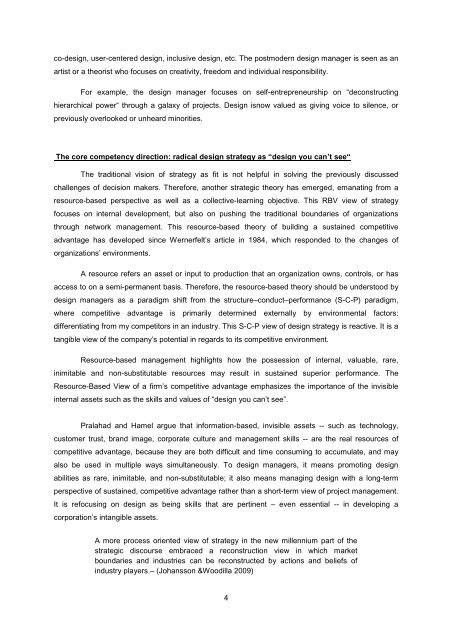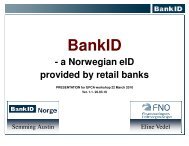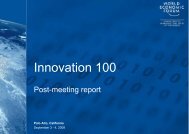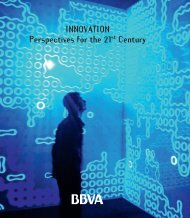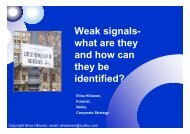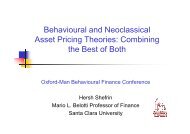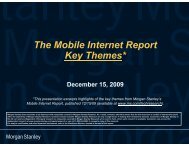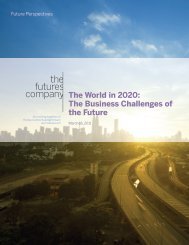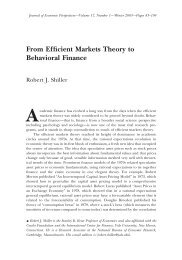Design Management as core competency
Design Management as core competency
Design Management as core competency
You also want an ePaper? Increase the reach of your titles
YUMPU automatically turns print PDFs into web optimized ePapers that Google loves.
co-design, user-centered design, inclusive design, etc. The postmodern design manager is seen <strong>as</strong> an<br />
artist or a theorist who focuses on creativity, freedom and individual responsibility.<br />
For example, the design manager focuses on self-entrepreneurship on “deconstructing<br />
hierarchical power“ through a galaxy of projects. <strong>Design</strong> isnow valued <strong>as</strong> giving voice to silence, or<br />
previously overlooked or unheard minorities.<br />
The <strong>core</strong> <strong>competency</strong> direction: radical design strategy <strong>as</strong> “design you can’t see“<br />
The traditional vision of strategy <strong>as</strong> fit is not helpful in solving the previously discussed<br />
challenges of decision makers. Therefore, another strategic theory h<strong>as</strong> emerged, emanating from a<br />
resource-b<strong>as</strong>ed perspective <strong>as</strong> well <strong>as</strong> a collective-learning objective. This RBV view of strategy<br />
focuses on internal development, but also on pushing the traditional boundaries of organizations<br />
through network management. This resource-b<strong>as</strong>ed theory of building a sustained competitive<br />
advantage h<strong>as</strong> developed since Wernerfelt’s article in 1984, which responded to the changes of<br />
organizations’ environments.<br />
A resource refers an <strong>as</strong>set or input to production that an organization owns, controls, or h<strong>as</strong><br />
access to on a semi-permanent b<strong>as</strong>is. Therefore, the resource-b<strong>as</strong>ed theory should be understood by<br />
design managers <strong>as</strong> a paradigm shift from the structure–conduct–performance (S-C-P) paradigm,<br />
where competitive advantage is primarily determined externally by environmental factors:<br />
differentiating from my competitors in an industry. This S-C-P view of design strategy is reactive. It is a<br />
tangible view of the company’s potential in regards to its competitive environment.<br />
Resource-b<strong>as</strong>ed management highlights how the possession of internal, valuable, rare,<br />
inimitable and non-substitutable resources may result in sustained superior performance. The<br />
Resource-B<strong>as</strong>ed View of a firm’s competitive advantage emph<strong>as</strong>izes the importance of the invisible<br />
internal <strong>as</strong>sets such <strong>as</strong> the skills and values of “design you can’t see”.<br />
Pralahad and Hamel argue that information-b<strong>as</strong>ed, invisible <strong>as</strong>sets -- such <strong>as</strong> technology,<br />
customer trust, brand image, corporate culture and management skills -- are the real resources of<br />
competitive advantage, because they are both difficult and time consuming to accumulate, and may<br />
also be used in multiple ways simultaneously. To design managers, it means promoting design<br />
abilities <strong>as</strong> rare, inimitable, and non-substitutable; it also means managing design with a long-term<br />
perspective of sustained, competitive advantage rather than a short-term view of project management.<br />
It is refocusing on design <strong>as</strong> being skills that are pertinent – even essential -- in developing a<br />
corporation’s intangible <strong>as</strong>sets.<br />
A more process oriented view of strategy in the new millennium part of the<br />
strategic discourse embraced a reconstruction view in which market<br />
boundaries and industries can be reconstructed by actions and beliefs of<br />
industry players.– (Johansson &Woodilla 2009)<br />
4


